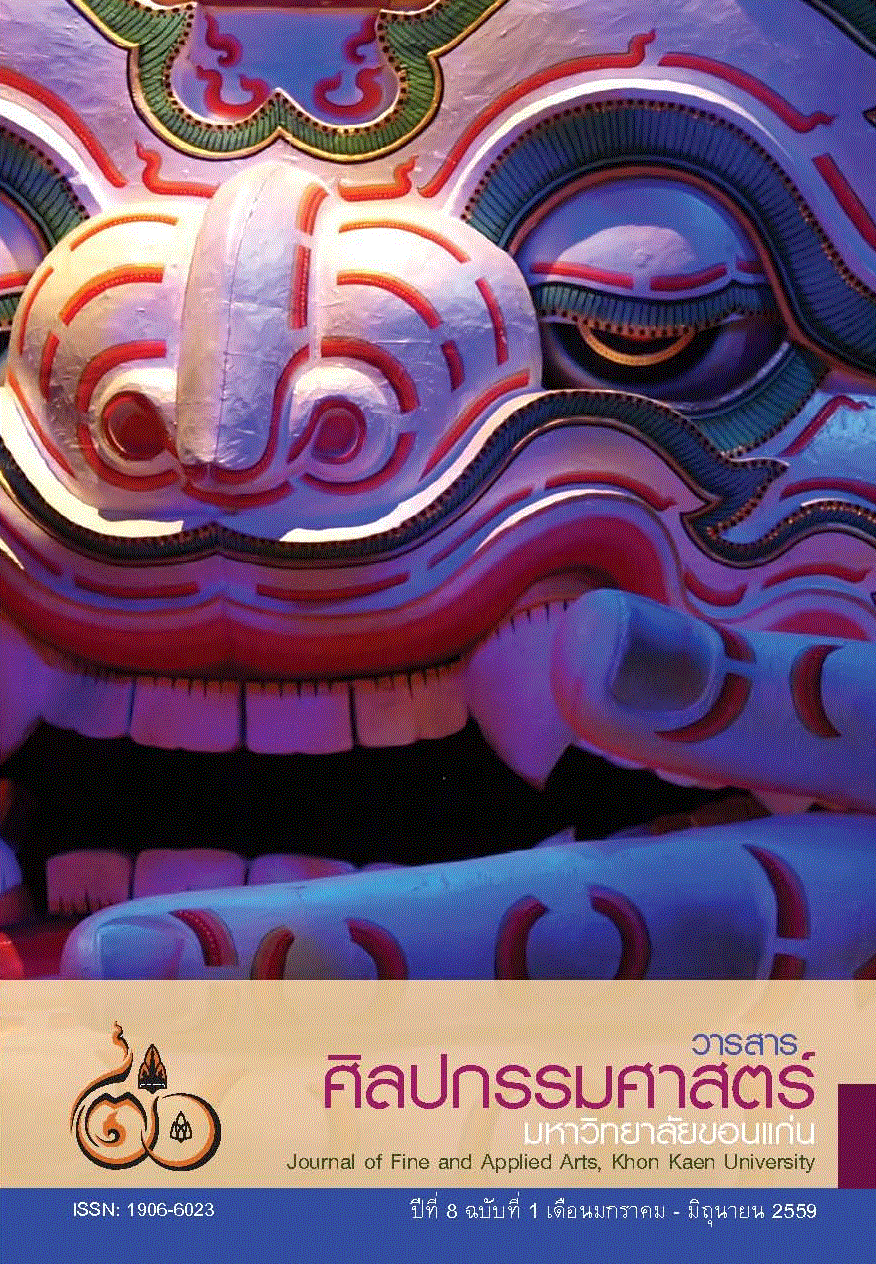ดนตรีของกลุมชาติพันธบรู เมืองวีละบุลี แขวงสะหวันนะเขต สาธาร ณรัฐประชาธิปไตยประชาชนลาว Music of the Bru Ethnic Group At Veelabulee District, Savannakhet Province Laos People Democratic Republic
Main Article Content
Abstract
การวิจัยเรื่อง ดนตรีของกลุมชาติพันธุบรู เมืองวีละบุลี แขวงสะหวันนะเขต สาธารณรัฐประชาธิปไตยประชาชนลาว มีจุดมุงหมายเพื่อ 1) ศึกษาประวัติความ เปนมาของกลุมชาติพันธุบรู ในเมืองวีละบุลี แขวงสะหวันนะเขต สาธารณรัฐ ประชาธิปไตยประชาชนลาว 2) ศึกษาดนตรีของกลุมชาติพันธุบรู ในเมืองวีละบุลี แขวงสะหวันนะเขต สาธารณรัฐประชาธิปไตยประชาชนลาว เครื่องมือที่ใชในการวิจัย ไดแก แบบสัมภาษณ แบบสังเกต มีการเก็บรวบรวมขอมูลเอกสารและขอมูลภาคสนาม ขอมูลภาคสนามไดจากการสัมภาษณ การสังเกต จากผูรู 7 คน ผูปฎิบัติ 4 คน และ ผูใหขอมูลทั่วไป 3 คน ในเขตพื้นที่เมืองวีละบุลี แขวงสะหวันนะเขต สาธารณรัฐ ประชาธิปไตยประชาชนลาว ตั้งแตเดือนมกราคม 2556 ถึง เดือนกันยายน 2558 นําขอมูลที่ไดมาตรวจสอบความถูกตองดวยวิธีการแบบสามเสา วิเคราะหตามความ มุงหมายที่ตั้งไว และนําเสนอผลการวิจัยดวยวิธีพรรณนาวิเคราะห ผลการวิจัยพบวา ดานประวัติความเปนมาของกลุมชาติพันธบรู ในเมือง วีละบุลีเปนกลุมชนดั้งเดิมในแถบลุมแมนํ้าโขง สืบเชื้อสายมาจากลุมชาวขอม เมื่อ ครั้งอาณาจักรเจนละเรื่องอํานาจ ซึ่งในอดีตเรียกวา ขา และภายหลังไดเปลี่ยนเปน “บรู” ซึ่งหมายถึง “ภูเขา” นิยมประกอบอาชีพทํานา ทําไร รับจาง ทํางานหัตถกรรม พื้นบาน สานเสื่อ ทอผา เลี้ยงวัว เลี้ยงควาย กลุมชาติพันธบรูในเมืองวีละบุรี มี 2 กลุมใหญๆ คือ กลุมแซงมะกอง และกลุมแซงตรี อาศัยตามแหลงนํ้าเปนปจจัย สําคัญ มีจํานวนประชากร 29 หมูบาน มีความใกลชิดทั้งในระดับครอบครัว เครือ ญาติ โดยยึดฮิตดาม คองผี (จารีตประเพณี) เปนแนวทางในการปฏิบัติตน มีขนบธรรมเนียมประเพณี 4 ดาน คือ ประเพณีกินงะ ประเพณีเหยาหรือระปม ประเพณีเลี้ยงผีนา และประเพณีบุญกินขาวใหม มีครอบครัว 2 ลักษณะ คือ ครอบครัวเดี่ยวและครอบครัวขยาย การปกครองของกลุมชาติพันธุบรูมี 2 ลักษณะ คือ ปกครองโดยผูนําชุมชน หรือ“เฒาแกบาน” ซึ่งทําหนาที่ใหคําปรึกษาดูแลความ สงบเรียบรอยของชุมชน และปกครองโดยหมอประกอบพิธีกรรม หรือ“จํ้า” ซึ่งทํา หนาที่เปนผูนําในการประกอบพิธีกรรมที่เกี่ยวกับผีปูตา ผีบรรพบุรุษ และผีบานผีเมือง ดานดนตรีของกลุมชาติพันธุบรู ในเมืองวีละบุลี แขวงสะหวันนะเขต สาธารณรัฐประชาธิปไตยประชาชนลาว พบวามี 4 ประเภท ประกอบดวย 1) ดาน เครื่องดนตรี พบวา เครื่องดนตรีของกลุมชาติพันธุบรู เปนสิ่งที่บงบอกถึงความเปน เอกลักษณประจํากลุมชาติพันธบรู ซึ่งเครื่องดนตรีที่พบลวนแตมีการประดิษฐจาก ภูมิปญญาที่ไดรับการสืบทอดมาจากบรรพบุรุษโดยทํามาจากไมไผและยังคงยึด รูป แบบดั้งเดิม เครื่องดนตรีที่พบ มี 4 ชนิด คือ ปยาว (ขลุย), ปตรี, ปกะลบ (หึน), ตรอ (ซอกระบอกไมไผ) นิยมบรรเลงในพิธีกรรมและบรรเลงเพื่อความผอนคลาย 2)ดานวงดนตรี พบวา วงดนตรีของกลุมชาติพันธุบรู ไดรับการสืบทอดจากรุนหนึ่งสู รุนหนึ่ง ทั้งยังคงอนุรักษแบบดั้งเดิมและมีการปรับเปลี่ยนไปบางเล็กนอยตามกระแส นิยม การประสมวงยังไมมีความชัดเจน วงดนตรีที่ปรากฏ คือ วงเหยา วงตะอวยหรือ ตะโอย วงตําปรอย ตําหลอยหรือตังหวาย และวงสะเนิดร 3)ดานบทเพลง พบวา บทเพลงไมมีรูปแบบที่ตายตัว ไมทราบนามผูแตงที่แนนอน กลุมเสียงเปนแบบ Pentatonic บทเพลงที่ปรากฏยังคงอนุรักษดั้งเดิมไวและเปนเอกลักษณของชาวบรู คือ เพลงเหยา เพลงตะอวยหรือตะโอย เพลงตําปรอย ตําหลอยหรือตังหวาย และ เพลงสะเนิดร
The research tools included an interview form and an observation form. Written document and fi eld data were collected. Field data were obtained through interviews and observations from 7 key-informants, 4 casual informants, and 3 general informants in Veelabulee District, Savannakhet Province Laos People Democratic Republic.The research was conducted between January 2013 To September 2015, The data were checked for their accountability with triangulation technique, analyzed according to the given objectives, and the results of the study were presented in a descriptive analysis form. The result of the research reveals that the history of the Bru Ethnic Group At Veelabulee District, Savannakhet Province Laos People Democratic Republic. original groups in the Mekong river basin. descended from a group of Khmer people when Kingdom of Chenla authority in the past, known as Kha and later was changed to “Bru” means “mountain” professional contract farming handicraft weaving, mat weaving, cattle, buffalo.The Bru Ethnic Group At Veelabulee District has 2 major groups at: Cangmakong Group and Cangtree Group.Relying on water sources is an important factor has a population 29 village are closer kinship in the family.by seizing tradition as guidelines for their implementation has 4 traditions (kin Nga, Yao or Rabream, offer sacrifi ces to a spirit and eat the new rice) The family has 2 types as single-family and extended family. The dominance of Bru ethnic Group has 2 types 1) community leader.or “Thau-kaa ban” Acting as consulting and peace of communities and 2) head rituals or “Jum” which is a leader in the rituals related ancestral ghosts and city ghost In terms music of the bru ethnic group at veelabulee district, included 4 type : 1) The instruments : The instruments of the bru ethnic group Is indicative identity of bru ethnic group,the instruments Invention of wisdom that inherited from their Ancestors, made from bamboo and traditional form.The instruments included: pi yao (long fl ute pipe),pi tree (reed pipe) , pi kalop (jaw’s harp), and tro (bamboo tube fi ddle.) performing in ritual and relax. 2) Music ensemble: Music ensemble of the bru ethnic group inherited from generation to generation. The conservation of traditional and modifi ed little the trend. and Music ensemble uncertainty. The Music ensemble included:Yao band, Ta-oy band, Tum –ploy Tum-Loy or Tang-way band and Sanead band 3) Musical composition: Musical composition was in monophonic texture. Songs were improvised, focusing on arousing the emotion the pentatonic scale. Song for the bru ethnic group original and identity. The song included: Yao , Ta-oy , Tum –ploy, Tum-Loy or Tang-way and Sanead
Article Details
Content and information in articles published in the Journal of Fine and Applied Arts of Khon Kaen University is regarded as the opinion and sole responsibility of the author(s) directly; therefore, editors are not obliged to agree to or share any responsibility with regard to the content and information that appears within these articles.
All articles, information, content, image, etc. that have been published in the Journal of Fine and Applied Arts of Khon Kaen University is the copyright of the Journal of Fine and Appllied Arts of Khon Kaen University. Any person or organization who wishes to distribute all or parts of the articles for further dissemination or other usage must first receive permission from the Journal of Fine and Applied Arts of Khon Kaen University before proceeding to do so.


